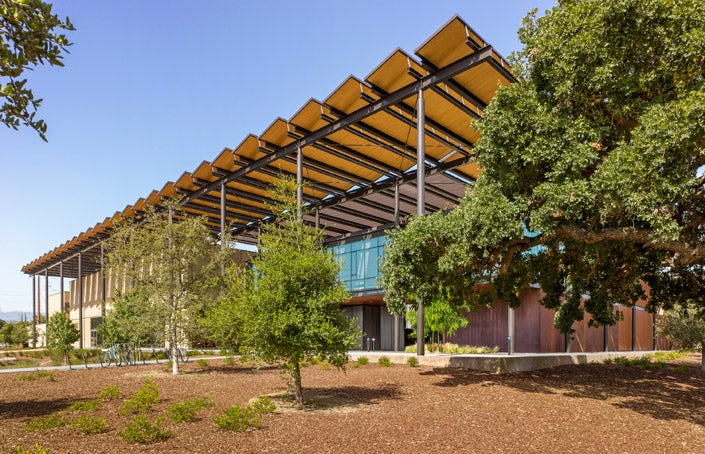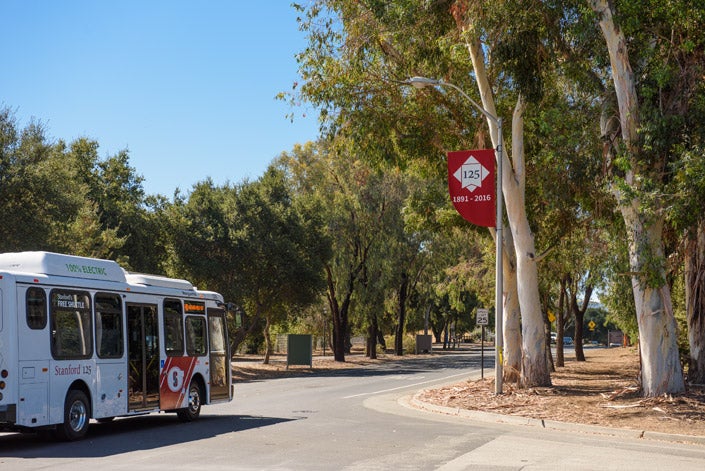Stanford submits application for updated long-term land use permit
The university’s application to Santa Clara County anticipates housing and academic space needs out to 2035. Stanford will continue to place a priority on sustainable development and alternative transportation strategies.
Stanford today submitted to Santa Clara County an application for an updated long-term campus land use permit.

The Central Energy Facility is one of the facilities at Stanford constructed under the 2000 General Use Permit. Stanford has applied to Santa Clara County for an updated General Use Permit that would take effect beginning in 2018. (Image credit: Courtesy ZGF Architects/Robert Canfield)
The proposal would allow Stanford to provide more on-campus housing in the coming years and to continue evolving its academic facilities to meet modern research and teaching needs. In doing so, Stanford would continue to follow a compact infill development strategy that preserves the existing campus footprint, protects natural resources and produces no net increase in automobile commute trips to the campus.
The application for an updated General Use Permit, as it is called, begins a review process with Santa Clara County that is expected to take approximately two years.
Stanford held three open houses earlier this year to inform local community members, answer questions and receive feedback prior to submittal of the application. Community engagement will continue to be an important element of the entire process.
“This application represents our ongoing commitment to plan responsibly for Stanford’s future land use, in a manner sensitive to the needs and concerns of our local communities and the surrounding region,” said Catherine Palter, associate vice president for land use and environmental planning. “This effort is about planning for the housing and academic facilities needed to sustain Stanford’s continued leadership in teaching and research, while actively promoting sustainability and smart transportation strategies.”
The full application and a summary of its contents are available on the web.
Planning for Stanford’s land use
The General Use Permit does not detail specific projects or buildings that might be constructed on the campus. Rather, it is part of an overall framework that governs Stanford’s campus land use over an extended period of time.
Stanford lands are located in parts of several local jurisdictions, with the academic campus predominantly located in unincorporated Santa Clara County. The university’s land use there is governed by two key Santa Clara County documents: The first is a Community Plan, adopted by the county in 2000, which provides an overall set of rules and policies for the university’s long-term land use. The second is a General Use Permit, which authorizes specific amounts of academic space and housing and establishes conditions of approval.
The county approved the current General Use Permit in 2000, authorizing the first increment of academic and support space, housing, parking and other infrastructure that could be constructed on campus in support of the Community Plan.

An electric Marguerite shuttle serves campus. Under the proposed General Use Permit, Stanford plans to continue to meet the goal of generating no net new automobile commute trips to the campus. (Image credit: L.A. Cicero)
In the next few years Stanford will reach completion of the new space authorized by the 2000 General Use Permit. That has led to proposal of an updated General Use Permit for the next period of years, anticipated to be 2018 to 2035.
Stanford’s application anticipates the university will continue to operate, as it has for the last 16 years, under the principles established in the 2000 Community Plan. Those include compact physical development of facilities, conservation of natural resources and continued use of alternative transportation strategies that limit automobile congestion.
The Community Plan also established an “academic growth boundary” that separates the urbanized campus area from the foothills above the campus. The new General Use Permit would preserve that boundary, as well.
Key elements of the application
The General Use Permit application aims to help Stanford achieve several things:
- Provide more on-campus housing. Stanford has focused from its earliest days on supporting a residential academic environment, believing that for students and faculty, living on campus enhances learning and fosters collaboration. The application would authorize Stanford to construct more housing on campus, further enhancing Stanford’s ability to connect its community with the academic life of the campus and the services the campus provides.
- Provide new research and teaching facilities with the latest equipment and designed for interdisciplinary collaboration. As knowledge evolves and new fields of research emerge, Stanford works to ensure that its facilities keep pace. Many new research fields have specialized space needs or depend upon increasingly large research instruments, and collaboration among scholars from different fields often requires new kinds of spaces that facilitate interaction. Whole new fields with their own facilities needs also are expected to develop in the coming years, just as fields such as neuroscience, stem cell research, materials science, cyber technologies and others have exploded over the last 15 years.
- Provide space for modest growth in undergraduate enrollments, which have been essentially flat for many years. Stanford has been planning for slow, gradual growth in the undergraduate student body in the coming years to provide greater access to what has become a highly selective undergraduate program.
The proposed General Use Permit, which is anticipated to cover campus growth from 2018 to 2035, would authorize a total of 2.275 million net new square feet of academic and academic support space. This amount is similar to the total square footage authorized by the 2000 General Use Permit, and it is equivalent to an average 1.2 percent annual increase in total academic and support space at Stanford during each of the years the 2018 General Use Permit is expected to be in effect.
The proposed permit would also allow construction of up to 3,150 net new housing units/student beds – also similar to the total number of units initially authorized under the 2000 General Use Permit. Up to 550 of these would be faculty/staff housing units.
The proposed permit also would authorize construction of up to 40,000 net new square feet of child-care and other trip-reducing facilities, to encourage fewer vehicle trips by providing more services on campus. A parking supply reserve is also included in the proposal; however, because Stanford actively encourages use of alternative transportation, this additional parking would not be built unless specific conditions occur.
The annual rate of construction on campus under the new General Use Permit would remain roughly consistent with that of recent decades, not factoring in the unique upcoming Escondido Village graduate student residences project. The growth also would be consistent with the “moderate growth scenario” analyzed in a 2009 Sustainable Development Study approved by Santa Clara County that showed how long-term building on Stanford’s main campus could be accommodated within the existing campus footprint.
Environmental and community features
Stanford’s planning as reflected in the application places a priority on demonstrating leadership in sustainability, energy efficiency and smart transportation solutions, along with regional contributions to key issues such as affordable housing. For instance:
- Continuation of “no net new commute trips.” Stanford plans to continue to meet the goal of generating no net new automobile commute trips to the campus, even as it adds new space. Stanford has had great success over the last 16 years in developing alternative transportation programs; today, fully half of Stanford employees who do not live on campus commute to work in ways other than driving alone. Additional initiatives are now being developed.
- Continued focus on sustainable development. Stanford intends to continue employing state-of-the art sustainable operations to minimize the impact of the campus on the surrounding community and the planet. Under the current General Use Permit, Stanford has reduced its potable water use by 30 percent; developed an innovative campus heating and cooling system that is 70 percent more efficient than the previous system; and invested in solar energy initiatives that will allow Stanford to obtain more than half of its electricity from the sun.
- Meeting and exceeding state environmental goals. Technical studies produced for the application estimate that even with the campus development envisioned to occur through 2035, the Stanford population’s vehicle miles traveled will fall well below regional averages. The campus also will meet and exceed the efficiency factor needed to meet the state’s goal of reducing greenhouse gas emissions to 40 percent below 1990 levels by 2030.
- Providing affordable housing. The county General Plan recognizes that during the current General Use Permit, Stanford has provided 816 new housing units on its campus that are affordable to low- and very low-income individuals. Stanford anticipates that under the proposed 2018 permit, it would construct approximately 900 additional graduate student beds, which would equate to roughly 450 more affordable housing units on the campus.
- Subsidies to provide additional affordable housing in the region beyond Stanford. Under the 2000 General Use Permit, Stanford has paid $26 million into a fund to subsidize affordable housing in nearby communities. This amount will grow to $39 million by the conclusion of the 2000 permit. Under the proposed 2018 permit, Stanford would make an estimated $56 million in these payments, with a focus on supporting affordable housing projects that are near major transit corridors.
“Stanford is a citizen of our local community and our global community,” Palter said. “As we plan, we continue to be focused on incorporating smart environmental practices and making positive contributions to our surrounding community and the broader region.”
Community participation and input
Stanford will conduct extensive community engagement as the General Use Permit process unfolds.
Building on the initial three open houses held in June 2016, the university will hold a Community Forum on the General Use Permit on Jan. 25, 2017, at 6 p.m. at the Mitchell Park Community Center in Palo Alto. This session will provide information to Stanford’s neighbors about the components of the application and solicit feedback.
The university also will be consulting with local governments and elected officials in surrounding communities as well as with Santa Clara County officials.
In addition, Santa Clara County will conduct a public meeting in early 2017 to obtain input on what issues should be addressed in the Environmental Impact Report the county will be preparing as part of its review of Stanford’s application.
“Stanford is not seeking any changes in the overarching planning principles approved by the Board of Supervisors in 2000,” said Jean McCown, associate vice president, government and community relations. “Our goal is to apply those principles to the next phase of campus development, anticipating Stanford’s academic and housing needs while actively addressing the priorities of our neighbors. We intend to be in ongoing dialogue with our neighbors on all of these issues.”
A website at gup.stanford.edu contains the application and related materials and will provide ongoing updates for the public. Hard copies of the application also will be available at Green Library at Stanford and at several branches of the City of Palo Alto’s public library: College Terrace, Downtown, Mitchell Park and Rinconada (formerly Main).
Feedback about Stanford’s application can be provided by email to Stanford2018GUP@stanford.edu. To sign up to receive community announcements related to the General Use Permit process, please visit gup.stanford.edu.
